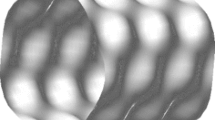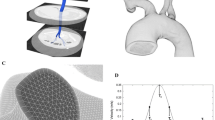Abstract
The sound generated by blood flow in stenosed arteries is investigated for a model that consists of a channel with a one-sided constriction. The blood flow-induced arterial “bruits” are computed directly using a hybrid approach wherein the hemodynamic flow field is solved by an immersed boundary, incompressible flow solver, and the sound generation is modeled by a first-principles approach that employs the linearized compressible perturbation equations. The transmission and propagation of the sound through the surrounding biological tissues is also modeled with a simplified, linear structural wave equation. The flow field inside the artery and the bruit sound signal at the epidermal surface are examined to delineate the precise source of the arterial bruit and the correlation between the bruit and the arterial wall pressure fluctuations. It is found that the bruits are related primarily to the time-derivative of the integrated pressure force on the post-stenotic segment of arterial wall. The current study provides a clear perspective on the generation of bruits from stenosed arteries and enables an assessment of the conjectures of previous researchers regarding the source of arterial bruits.







Similar content being viewed by others
References
Ahmed SA, Giddens DP (1983) Velocity measurements in steady flow through axisymmetric stenoses at moderate Reynolds number. J Biomech 16:505–516
Ahmed SA, Giddens DP (1983) Flow disturbance measurements through a constricted tube at moderate Reynolds numbers. J Biomech 16:955–963
Allen JB (1977) Short term spectral analysis, synthesis, and modification by discrete Fourier transform. IEEE T Acoust Speech ASSP-25(3): 235-238
Ask P, Hok B, Lyold D, Terio H (1995) Bio-Acoustic signals from stenotic tube flow: state of the art and perspectives for future methodological development. Med Biol Eng Comput 33:669–675
Banks H, Barnes J, Eberhardt A, Tran H, Wynne S (2002) Modeling and computation of propagating waves from coronary stenoses. Comput Appl Math 21:767–788
Baron C, Aubry J-F, Tanter M, Meairs S, Fink M (2009) Simulation of intracranial acoustic fields in clinical trials sonothrombolysis. Ultrasound Med Biol 35(7):1148–1158
Borisyuk AO (1999) Noise field in the human chest due to turbulent flow in large blood vessel. Flow Turbul Combust 61:269–284
Borisyuk AO (2002) Experimental study of noise produced by steady flow through a simulated vascular stenosis. J Sound Vib 256(3):475–498
Bruns DL (1959) A general theory of the causes of murmurs in the cardiovascular system. Am J Med 27(3):360–374
Duncan GW, Gruber JO, Dewey CF, Meyers GS, Lees RS (1975) Evaluation of carotid stenosis by phonoangiography. New Engl J Med 293:1124–1128
Einstein DR, Kunzelman KS, Reinhall PG, Cochran RP, Nocosia MA (2004) Haemodynamic determinants of the mitral valve closure sound: a finite element study. Med Biol Eng Comput 42(6):832–846
Fredberg JJ (1974) Pseudo-sound generation at atheroesclerotic constrictions in arteries. Bull Math Biol 36:143–155
Fredberg JJ (1977) Origin and character of vascular murmurs: model studies. J Acoust Soc Am 61:1077–1085
Gaitonde D, Shang JS, Young JL (1999) Practical aspects of higher-order accurate finite volume schemes for wave propagation phenomena. Int J Numer Method Eng 45:1849–1869
Goss SA, Frizzell LA, Dunn F (1979) Ultrasonic absorption and attenuation in mammalian tissues. Ultrasound Med Biol 5:181–186
Goss SA, Frizzell LA, Dunn F (1980) Dependence of the ultrasonic properties of biological tissue on constituent proteins. J Acoust Soc Am 67(3):1041–1044
Howe MS (1998) Acoustics of fluid–structure interactions. Cambridge University Press, New York, pp 59–61
Jones SA, Fronek A (1987) Analysis of break frequencies downstream of a constriction in a cylindrical tube. J Biomech 20:319–327
Kirkeeide RL, Young DF, Cholvin NR (1977) Wall vibrations induced by flow through simulated stenoses in models and arteries. J Biomech 10(7):431–441
Lee SW, Loth F, Royston TJ, Fischer PF, Bassiouny HS, Grogan JK (2005) Flow induced vein wall vibration in an arteriovenous graft. J Fluid Struct 20:837–852
Lees RS, Dewey C Jr (1970) Phonoangiography: a new noninvasive diagnostic method for studying arterial disease. Proc Natl Acad Sci 67:935–942
Lele SK (1992) Compact finite difference schemes with spectral-like resolution. J Comput Phys 103:16–42
Miller A, Lees RS, Kistler JP, Abbott WM (1980) Effects of surrounding tissue on the sound spectrum of arterial bruits in vivo. Stroke 11:394–398
Mittal R, Simmons SP, Najjar F (2003) Numerical study of pulsatile flow in a constricted channel. J Fluid Mech 485:337–378
Mittal R, Dong H, Bozkurttas M, Najjar FM, Vargas A, von Loebbecke AA (2008) A versatile sharp interface immersed boundary method for incompressible flows with complex boundaries. J Comput Phys 227:4825–4852
Moon YJ, Seo JH, Bae YM, Roger M, Becker S (2010) A hybrid prediction method for low-subsonic turbulent flow noise. Comput Fluids 39:1125–1135
Murgo JP (1998) Systolic ejection murmur in era of modern cardiology, what we really know? J Am Coll Cardiol 32(6):1596–1602
Narasimhan C, Ward R, Kruse KL, Gudatti M, Mahinthakumar G (2004) A high resolution computer model for sound propagation in the human thorax based on the visible human data set. Comput Biol Med 34:177–192
Nichols WW, O’Rourke MF (1998) McDonald’s blood flow in arteries: theoretical, experimental, and clinical principles, 4th edn. Oxford University Press, New York, pp 37-38, 396-401
Okita K, Ono K, Takagi S, Matsumoto Y (2010) Development of high intensity focused ultrasound simulator for large-scale computing. Int J Numer Method Fluids 65:43–66
Owsley NL, Hull AJ (1998) Beamformed nearfield imaging of a simulated coronary artery containing a stenosis. IEEE T Med Imaging 17:900–909
Pedley TJ (1980) The fluid mechanics of large blood vessels. Cambridge University Press, New York, p 30
Ronan JA Jr (1992) Cardiac auscultation: the third and fourth heart sounds. Heart Dis Stroke 1(5):267–270
Semmlow J, Rahalkar K (2007) Acoustic detection of coronary artery disease. Annu Rev Biomed Eng 9:449–469
Seo JH, Moon YJ (2006) Linearized perturbed compressible equations for low Mach number aeroacoustics. J Comput Phys 218:702–719
Seo JH, Mittal R (2011) A high-order immersed boundary method for acoustic wave scattering and low Mach number flow induced sound in complex geometries. J Comput Phys 230:1000–1019
Varghese SS, Frankel SH, Fischer PF (2007) Direct numerical simulation of stenotic flows. Part 1. Steady flow. J Fluid Mech 582:253–280
Varghese SS, Frankel SH, Fischer PF (2007) Direct numerical simulation of stenotic flows. Part 2. Pulsatile flow. J Fluid Mech 582:281–318
Wang J, Tie B, Welkowitz W, Semmlow J, Kotis J (1990) Modeling sound generation in stenosed coronary arteries. IEEE T Biomed Eng 37:1087–1094
Yazicioglu Y, Royston TJ, Spohnholtz T, Martin B, Loth F, Bassiouny H (2005) Acoustic radiation from a fluid-filled, subsurface vascular tube with internal turbulent flow due to a constriction. J Acoust Soc Am 118(2):1193–1209
Acknowledgments
This research is partially supported by the CDI Program at NSF through Grant IOS-1124804. This work used the Extreme Science and Engineering Discovery Environment (XSEDE), which is supported by NSF Grant Number TG-CTS100002.
Author information
Authors and Affiliations
Corresponding author
Rights and permissions
About this article
Cite this article
Seo, J.H., Mittal, R. A coupled flow-acoustic computational study of bruits from a modeled stenosed artery. Med Biol Eng Comput 50, 1025–1035 (2012). https://doi.org/10.1007/s11517-012-0917-5
Received:
Accepted:
Published:
Issue Date:
DOI: https://doi.org/10.1007/s11517-012-0917-5




